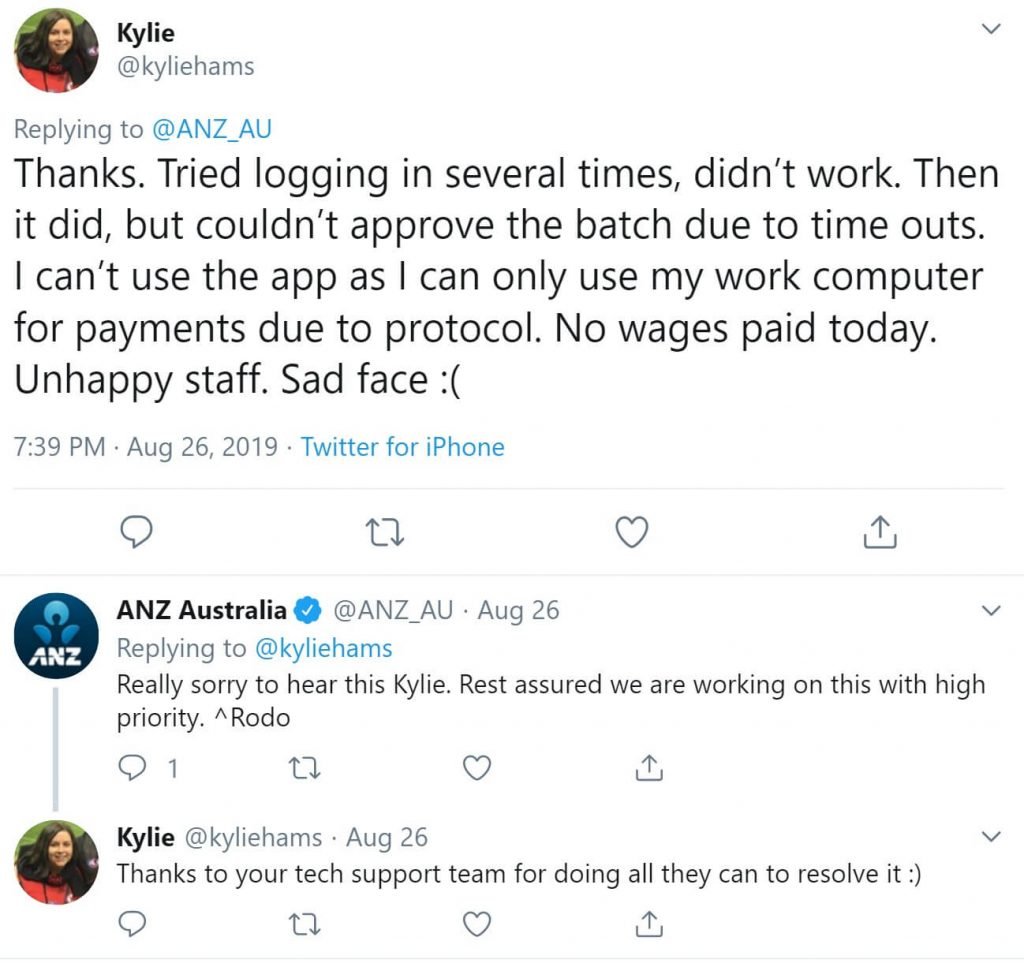All business issues become social media issues.

Earlier this week, ANZ Bank experienced an outage across its online banking platform. While it wasn’t as painful for customers as the Telstra outage in July that impacted a wide range of financial institutions and retailers, it was another simple reminder that the unexpected happens and that all organisations can benefit from taking stock and reviewing how they can improve their customer service.
Perhaps more poignantly, it was a reminder that though problems like these rarely start on social media, social media is where they’re seen. Often first, farthest and fiercest, according to ANZ’s Twitter and Facebook pages.
Neither ANZ nor any other organisation for that matter can control when outages or issues like these will arise. But what they can control is how they respond. Often this is where the brand reputation and customer retention battles are fought in the age of social media and consumer empowerment. People expect organisations to be attentive, responsive and compassionate in response to a crisis.
Learning from others’ experiences: managing crises with social media.
So, what can this experience remind us to do in our own crisis moments?
This is a timely, relevant example to raise ideas that strengthen your own processes and ultimately lead to a better customer experience. Because social customer service teams rarely cause issues – but are often called on to respond first and fastest – they must always be prepared.
We’ve summarised ten best practices to help guide your own social media customer service efforts below.
Ten best practices for social media customer service teams.
1. Whether your organisation uses social media for customer service or not, it’s vital to monitor social media conversations relating to your brand or products to identify issues immediately. Setup social media listening and have alerts in place to flag emerging issues within and outside your communities.
2. Timeliness is key, so acknowledge the issue as soon as you are aware of it and take control of the narrative up front. Even if you’re seeking information internally or replying to people privately, your community can only see your public actions and will assume you’re either unaware or in lockdown mode if things appear that way. Perception is reality in a crisis.
3. Tools are wonderful and well worth using to minimise risk, triage responses and mitigate comments slipping through the cracks. Ensure they are setup and configured before a crisis hits so that you can separate issue-related responses from BAU responses and team members know where to focus their efforts when stakes are high.
4. Customer service channels and teams must work in unison, regardless of where the problem originates. As a social media customer service agent, your job is not just to respond to customers but to capture insights on emerging issues that will help your colleagues fix the bigger issue sooner and avoid facing new problems.
5. Building on this, ensure you have established feedback loops with internal teams to share information and update affected customers quickly. While this is of course important to resolve issues, these established feedback loops will also help executives identify when an issue may become a crisis, as opposed to isolated trolling or independent, small scale issues.
6. During the crisis, have processes in place to help your team function according to the needs of your community, while also considering your business needs. Of course it will take time for support staff to come online during peak loads or issues, but having a process and escalation guidelines in place prior to the event will minimise further customer disruptions.
7. Always consider the customer journey while managing your own internal processes. Yes – you might be four hours in and have moved onto other tasks, but they may be seeing things for the first time and without your context. Use platform functionality (such as pinned tweets or posts or a system outage link and landing page) where possible, provide issue status updates in reverse chronological order for quick scanning and, if the issue isn’t a quick fix, ensure you pause all social advertising or scheduled posts to avoid unintended consequences.
8. It may sound strange, but it always pays to be human. In times of pressure and chaos, it absolutely pays to follow procedure to minimise errors, but don’t forget to empathise with the situation in your responses. Take a moment to understand someone’s issue before replying. And, where and when possible, try to follow up with people to demonstrate your willingness to know they’re ok. Even if they don’t respond, use issues as a chance to show them you care.
9. Even when the issue seems to be resolved, what your customers see may be different to what you know. It’s important to remember they’re never ‘wrong’ and that you may still need to resolve their specific challenge even after your systems are back online. This can be a delicate process if you’re asking for them to explain their problem or take extra steps to reach a resolution – tread carefully and respectfully.
10. Finally, it’s always worth remembering your customers are flagging you have a problem not because they want you to fail but because they want you to fix it. Yes, they may be frustrated, but they ultimately just want your product or service to work. It pays to keep that ‘partnership’ mindset in each individual interaction so you can help them reach the right outcome.
Feel free to contact us if you have any questions on how to introduce some of these changes within your own teams.
Continue learning: download our latest social media customer service resource.
Our free social media customer service tips and resource will take you through the steps needed to deliver immediate and sustainable benefits to your team, organisation and customer. Though this is just the beginning, we know your team will be better placed to deliver exceptional customer service through this review and we look forward to hearing the results.